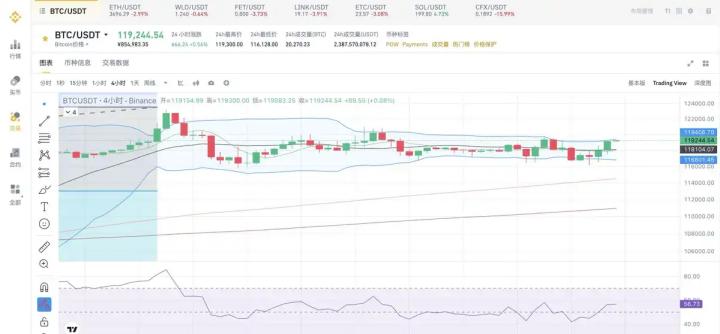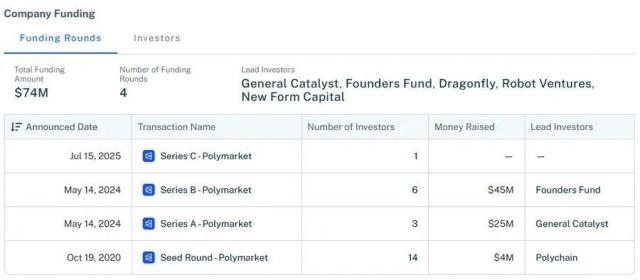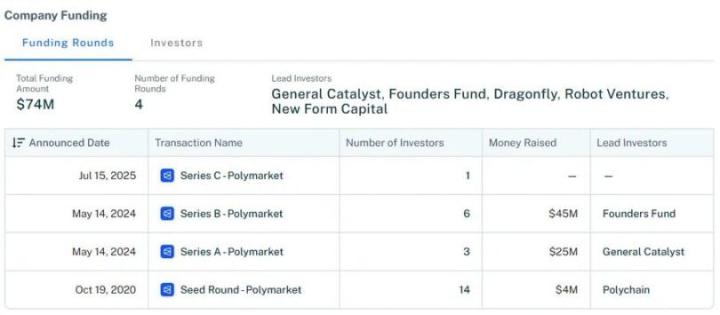In the first quarter of 2025, the financial report released by Coinbase presented a challenging picture to investors: As one of the world's largest cryptocurrency trading platforms, Coinbase is facing problems such as a sharp decline in net profit, shrinking trading volume, and loss of market share. The core business that once supported its market position is facing unprecedented pressure.

In the face of the crisis, Coinbase has also demonstrated its determination: rapid acquisitions and cross-field business integration. Coinbase is promoting the reconstruction of its business around the development of the Base chain and the expansion of institutional customers. This also provides an inspiring direction for other CEXs on how to break through the existing framework and seize future growth opportunities in the increasingly competitive market.
“CEX Crisis” in Financial Reports
Although it is still one of the world's largest crypto trading platforms, Coinbase's financial report for the first quarter of 2025 revealed its anxiety. Total revenue reached US$2 billion, a year-on-year increase of 24.2%, but this increase obviously failed to make up for the pressure it faced.
Especially in the context of a sharp decline in net profit of 94%. The net profit of $66 million was far below investors' expectations.
Spot trading revenue, once the main source of Coinbase's revenue, showed a clear downward trend in this year's financial report. Institutional trading revenue fell 30% year-on-year, and retail trading revenue also fell 19%. The shrinking trading volume reflects that CEX's traditional profit model is facing severe tests.
The decline in spot trading volume is due to the cooling of the crypto market itself. After January 2024, the price volatility of mainstream crypto assets such as Bitcoin and Ethereum has weakened. Compared with the volatile market environment in the past, the activity of investors has declined significantly. Both institutional investors and retail traders no longer trade as frequently as before.

However, in addition to price performance, what really triggers the butterfly effect is a series of factors intertwined together, which jointly drive the major reshuffle of CEX.
The rise of ETFs is undoubtedly one of the key factors. In addition to Bitcoin, mainstream currencies with large market capitalizations such as Ethereum, Solana, and XRP have also passed ETFs in this round. These proportions once accounted for the vast majority of Coinbase's spot trading volume. Compared with CEX's spot trading fee of 0.5%, the annual management fee of 0.1%-0.5% has led some investors to choose ETFs.
The prosperity of the on-chain and meme markets has also exacerbated the loss of traders. The wealth-creating effect of the on-chain in this cycle has made crypto-native users and newcomers more and more accustomed to trading on the chain. More users have begun to regard CEX as a "cross-chain bridge" for deposits and a "wallet" for storing stablecoins.
In addition, decentralized derivatives platforms such as Hyperliquid have risen rapidly. With a more flexible listing mechanism, higher leverage, and more diverse trading products than compliant trading platforms such as Coinbase, they have attracted a large number of contract users from strictly regulated regions such as the United States, accelerating the loss of users to the chain.
To make matters worse, some time ago, traditional brokerages such as Robinhood announced their entry into the crypto market, further impacting Coinbase’s market share. Robinhood’s main customer group is young investors who trade in traditional financial markets. This group is already very interested in the crypto market and is also an incremental market for CEX platforms such as Coinbase to compete for.
But for this user group, brokers such as Robinhood clearly provide a more familiar trading interface and lower fees. And its compliance may attract crypto whale interested in US stocks, which undoubtedly compresses Coinbase's future growth space again.
When trading platforms no longer rely on trading business
With the decrease in traffic and the loss of users, Coinbase's competitors have realized that it is difficult to maintain market share by relying solely on spot trading business.
OKX started to lay the infrastructure of OKX Wallet as early as the inscription period, trying to become the user's on-chain entrance through its convenient product experience and comprehensive services. Binance launched the Alpha trading reward activity to attract a large number of on-chain users to flow into BSC, and deeply integrated the Alpha section into the main site to achieve traffic feedback.
Unlike its competitors, Coinbase did not invest heavily in developing new products. Instead, it used its own advantages in compliance and resources to "form alliances" and use acquisitions and business cooperation as the main means to rapidly advance the construction of the Base chain, and exert its strength in the institutional market to build a new competitive landscape.
Buy, buy, buy!
Acquisition, a common means of transformation for Web2 companies in the face of intensified industry competition, has become Coinbase's primary measure to cope with market challenges and achieve transformation. In just six months, Coinbase used its strong cash flow as a trading platform to acquire four companies: Spindl, Iron Fish, Deribit and Liquifi.
CEO Brian Amsterang also said: "The company has a strong balance sheet and as a public company has liquidity available for mergers and acquisitions. In the future, we will continue to focus on companies that can promote Coinbase product development and growth."
It is worth noting that these four acquired companies have no direct connection with Coinbase’s past main business. Obviously, Coinbase is not simply acquiring to save or grow its spot trading business. Instead, these acquisitions are all to explore new growth points.
Three of the acquisitions - Spindl, Iron Fish and Liquifi - all serve the same direction - the construction of the Base chain.
Although Base Chain has never been able to surpass Solana in the fierce competition in the on-chain ecosystem in the past few years, unlike Solana and BSC's strategy of attracting retail traders by creating memes, Base's growth has emphasized "Builder First" from the beginning. Its ecosystem director Jesse Pollak has also publicly stated many times that he wants to create a friendly development environment for developers, and its priority is even before attracting users.
The businesses of Spindl, Iron Fish team and Liquifi are directly focused on empowering developers on the chain. These acquisitions provide developers with a full range of tools and services from marketing support, privacy technology to token management, reducing the difficulty and cost of developing on the Base chain.
For developers, promoting their applications to a large number of users has always been a major challenge. Traditional advertising platforms cannot meet the model of a decentralized ecosystem. Spindl, acquired by Coinbase in January this year, is a company that provides on-chain advertising solutions. It was founded by Antonio García Martínez, a core member of the Facebook advertising team.
Spindl has built an on-chain advertising technology stack through smart contracts, allowing developers to directly place ads and acquire users on the chain without relying on centralized platforms or Twitter KOLs. This innovative advertising method provides on-chain developers with greater transparency, more control, and greatly reduces advertising costs.
In addition to advertising and marketing, privacy protection is also one of the pain points for on-chain developers. Privacy issues are particularly valued by crypto-native users. Many degen whale leave CEX and come to the chain because the chain can better protect their privacy and anonymity. However, in actual development, developers face problems such as complex privacy protection technology and difficulty in implementation.
In March, Coinbase acquired the Iron Fish team. Iron Fish was originally a privacy chain built with zero-knowledge proof (zk-SNARKs) technology to ensure the privacy of users' transactions on the chain. The Iron Fish team has a unique advantage in helping developers build privacy-preserving, secure, and compliant privacy protection tools.
After being acquired by Coinbase, its team will build a new privacy module on Base and develop privacy-preserving primitives to help developers on Base more smoothly develop secure, transparent, and privacy-preserving applications.
At the same time, for crypto startups, the issuance and management of tokens is also a complex task, involving equity structure, airdrop design, token unlocking, tax compliance, etc. Most developers lack experience in this area, which requires them to invest a lot of time, energy and cost in addition to project development to cope with the various challenges of token issuance and management.

Liquifi, which Coinbase just acquired in July, is a key platform to solve this problem. Liquifi provides on-chain developers with a full range of token management services, including equity structure management, vesting period arrangement, airdrop management, and tax compliance.
Some well-known star projects: Uniswap Foundation, Ethena, and OP Labs have also used Liquifi to manage their tokens and airdrops.
Notably, Liquifi will also be integrated into Coinbase Prime — Coinbase’s platform designed specifically for institutional users.
Through this integration, the token management, equity structure design and compliance services provided by Liquifi will also directly serve institutional clients. Under the trend of RWA and coin-stock integration, this function will provide greater convenience for traditional financial institutions and US stock companies that issue tokens on the blockchain.
In addition to acquiring products that serve on-chain developers, Coinbase also acquired Deribit for $2.9 billion in May to enhance its competitiveness in the derivatives trading market.
For trading platforms, contract trading is usually more stable and has higher profit potential than spot trading. Derivatives tools not only attract retail users who are keen on high-leverage trading, but also serve as an indispensable hedging and speculation tool for institutional investors. However, due to the strict regulation of the contract market in the United States, Coinbase's performance in this field lags far behind its offshore competitors.
As spot trading revenue cannot support the pressure of financial reports, the acquisition of Deribit has almost become a move that Coinbase has to make. Although the price is not cheap, Deribit's institutional user base and its leading position in the options market are highly consistent with Coinbase's strategic direction, and also provide an ideal springboard for its smooth entry into the derivatives market.
After the acquisition, Coinbase quickly launched a perpetual contract product that complies with the supervision of the U.S. Commodity Futures Trading Commission (CFTC) at the end of June. Its product features of no quarterly expiration, 24/7 trading, and close tracking of spot prices are based on Deribit's existing product development.
"Amazon of Crypto"
If the acquisition is a violent breakthrough of Coinbase's trading revenue ceiling, then its ongoing business integration and expansion is a deeper "identity reshaping."
It is redefining the underlying architecture of the crypto industry in the way that traditional technology companies do: not by offering incentives and grabbing traffic to make prices rise or fall, but by diving step by step into the settlement network, payment system, and identity layer infrastructure.
This "doing the heavy work and not showing your face" transformation is taking shape with a clear outline: building a closed loop around stablecoin payments, social wallets, and on-chain transaction behaviors, and gradually transforming itself into a hybrid of Apple + Visa + AWS in the Web3 world within a compliance framework.

The first pillar of this structure is the stablecoin payment network centered around USDC. Coinbase does not have the right to issue USDC, but the Centre Consortium co-founded with Circle gives it a position almost equivalent to that of a "co-founder" in terms of technical governance, audit standards, and even market expansion.
In this profit-sharing structure, Coinbase took more than half of the huge interest rate spread of USDC: Circle's interest income in 2023 was $1.6 billion, of which $900 million went to Coinbase. However, it is this "lying profit within the agreement" model that also buried structural risks - Circle was dissatisfied with Coinbase's insufficient contribution but the greatest benefit, and began to actively adjust the profit-sharing rules in 2024.
Coinbase quickly realized the essence of the problem: the future of USDC must run in a stronger scenario and cannot rely solely on the cold start of the trading platform.
So it began to change from "getting profits" to "building scenarios", and launched a USDC deposit subsidy activity in the first quarter of 2024 to forcibly increase the proportion of USDC on the platform; at the same time, the more critical action was to officially enter the Web2 merchant side: cooperate with Shopify to launch the USDC payment API to help merchants complete the complete process of on-chain collection, off-chain settlement, and fiat currency reconciliation.
This is no longer a demonstration of "whether stablecoins can be used for payment", but directly turning Coinbase into a payment processor with merchant settlement capabilities. It is trying to embed a crypto-financial settlement pipeline in the real-world cash registers and ERP systems.
This pipeline is not alone. In fact, the real important driving force behind Coinbase is a16z.
a16z is not only the earliest seed investor of Coinbase, but also a long-term heavy supporter of Circle (issuer of USDC). In the design of Centre, a16z played a strategic role, and its encryption team has been promoting the core concept of "stablecoin is the TCP/IP of Internet finance".
In a16z's territory, Coinbase is the real payment portal that connects users with fiat currency, while USDC is the value protocol that can penetrate different economic systems. The combination of the two is a deep synergy in capital, governance, and products, and is also an attempt to systematically reconstruct the traditional financial clearing network (Visa/Swift).
If payment is the entrance to funds, then the wallet is the entrance to identity and traffic.
Coinbase has recently made several updates on the wallet side that have not received much attention: introducing the "Smart Wallet", which does not seed phrase and can be created with one click; integrating on-chain identity, NFT display, check-in tasks and other functions, and even connecting to the social protocol Lens, trying to build an interactive, humanized and sticky "wallet social network".
The latest version of Coinbase Wallet has pushed the "account" to the forefront of on-chain social and creator economy: it not only integrates Farcaster's information flow, short videos and chats, but also embeds Mini App, AI Agent and on-chain friend interaction modules, attempting to create a "crypto circle of friends" that carries both transaction execution and social distribution.
In the social scene where Web3 has always lacked explosive products, Coinbase does not want to create another Lens, but to turn traders into social players, wallets into feeds, and interactions into part of on-chain consumption. It is using wallets to rewrite the way users stay on the chain.
This is not just a minor functional optimization. The wallet is the user's first interface on the chain. Once it is seized by Coinbase, it will not only control the "money", but also the user's behavior trajectory, on-chain identity, and social relationships.

Its goal is obviously to form a closed loop with the Base chain.
Coinbase launched the Base public chain in 2023, attracting a large number of developers and dApps in a short period of time. However, what really retains users is not developer subsidies, but "self-contained wallet entrance". Directly guiding users to participate in mint, bridging, and interaction through the wallet, and then binding on-chain assets through the identity system and NFT, this is a sustainable traffic model.
You can think of this model as the Web3 version of the "iOS ecosystem": Coinbase Wallet is the App Store, Base is iOS, and USDC is Apple Pay. After the three are closed, Coinbase no longer relies on volatility and trading volume to make money, but instead extracts continuous "on-chain taxes" from the flow of "identity + funds + transactions + social interaction."
Related reading: One step faster than Twitter, the new Coinbase Wallet evolves into WeChat
The capital founder of this ecosystem is also inseparable from a16z - it is both an advocate of the Wallet-as-infrastructure model and a promoter of the Base ecosystem.
As retail transaction fees gradually decline and high-profit businesses come under pressure, Coinbase's Prime service on the institutional side is also playing the role of "cash flow ballast."
Coinbase Prime is a trading, clearing and custody platform for institutional clients, serving more than 500 hedge funds, market makers and asset management companies, and is the main provider of USDC custody.
Although Prime’s specific financial data has not been disclosed, it is generally estimated that it has a very high share of Circle’s interest income and is the key backend that drives Coinbase to maintain a stable income structure. If on-chain securities assets such as RWA and STO become a reality in the future, Coinbase Prime can even expand to become the Goldman Sachs and BlackRock on the chain.
This is also the most fundamental difference between Coinbase and many Web3 trading platforms: it does not rely on the emotional fluctuations of users, but tries to control the user's infrastructure - whether it is the import and export of assets (USDC), the starting point of the account (Wallet), or the terminal of the transaction (Base), what it wants to do is to be an irreplaceable node in the on-chain financial system.
As a result, we see an extremely restrained but also very imaginative path: instead of collecting transaction fees, issuing incentives or launching new currencies, we build a compliant version of the Web3 core stack for liquidity, identity and clearing and settlement.
Coinbase may not be the busiest trading platform, but it is becoming the most important "settlement layer company."
While other platforms are still chasing short-term fluctuations, it has already entered a long cycle of slow variables: turning encryption into infrastructure, transactions into settlements, and users into network nodes. This slow variable may be the capital story that can truly transcend regulation and the market in the future.
From a currency trader to a financial foundation
Coinbase was once caught in an anxious cycle of declining trading volume and sharply reduced profits. Spot revenue is unsustainable, ETFs are eroding user minds, Robinhood is eyeing it, and on-chain users are turning to native protocols such as Hyperliquid. The "old order" of traditional CEX is accelerating its collapse.
However, Coinbase’s response is not to increase fees or grab currencies, but to choose a deeper and heavier route: acquiring infrastructure, connecting with institutional capital, and building an on-chain foundation.
Spindl, Iron Fish, and Liquifi have built the core tool stacks needed by developers for Base, focusing on on-chain marketing, privacy compliance, and token management. The heavy acquisition of Deribit has made up for its long-missing derivatives sector, and re-competed for high-net-worth users and institutional funds.
These seemingly scattered puzzle pieces ultimately point to a unified direction: Coinbase is no longer a trading platform, but is building an infrastructure stack for an on-chain financial system. Base is its operating system, Wallet is the account layer, USDC is the funding channel, and Prime is the institutional engine - it is building a "Web3 middle platform" that is composable, embeddable, and trusted by institutions.
On this middle platform, it no longer relies on fluctuations in trading volume to generate revenue, but instead achieves continuous "protocol-level taxation" by building a closed loop of on-chain behaviors such as identity, payment, transaction, and social interaction; it no longer caters to the emotional fluctuations of retail investors, but instead attracts developers and service agencies to open up the interface between the real world and the chain.
Its strategy has surpassed the dimensions of competitors such as Binance and Robinhood - it is not about being another trading platform, but about defining who will build the next generation of financial systems:
While others are still fighting a price war over transaction fees, Coinbase has already started selling the entire crypto-financial operating system.
This is not a withdrawal, but a reshaping of its identity. And its ultimate opponent may no longer be Binance, but traditional finance itself.
Click here to learn about BlockBeats' BlockBeats job openings
Welcome to join the BlockBeats official community:
Telegram subscription group: https://t.me/theblockbeats
Telegram group: https://t.me/BlockBeats_App
Official Twitter account: https://twitter.com/BlockBeatsAsia







